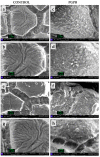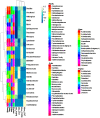Allium cepa L. Inoculation with a Consortium of Plant Growth-Promoting Bacteria: Effects on Plants, Soil, and the Autochthonous Microbial Community
- PMID: 33808642
- PMCID: PMC8003585
- DOI: 10.3390/microorganisms9030639
Allium cepa L. Inoculation with a Consortium of Plant Growth-Promoting Bacteria: Effects on Plants, Soil, and the Autochthonous Microbial Community
Abstract
The present work was aimed at investigating the effects of a four bacterial strain consortium-Azospirillum brasilense, Gluconacetobacter diazotrophicus, Herbaspirillum seropedicae, and Burkholderia ambifaria-on Allium cepa L. and on soil health. The bacterial consortium was inoculated on seeds of two different onion varieties; inoculated and Control seeds (treated with autoclaved inoculum) were sown in an open-field and followed until harvest. Plant growth development parameters, as well as soil physico-chemical and molecular profiles (DNA extraction and 16S community sequencing on the Mi-Seq Illumina platform), were investigated. The results showed a positive influence of bacterial application on plant growth, with increased plant height (+18%), total chlorophylls (+42%), crop yields (+13%), and bulb dry matter (+3%) with respect to the Control. The differences between Control and treatments were also underlined in the bulb extracts in terms of total phenolic contents (+25%) and antioxidant activities (+20%). Soil fertility and microbial community structure and diversity were also positively affected by the bacterial inoculum. At harvest, the soil with the presence of the bacterial consortium showed an increase in total organic carbon, organic matter, and available phosphorus, as well as higher concentrations of nutrients than the Control. The ecological indexes calculated from the molecular profiles showed that community diversity was positively affected by the bacterial treatment. The present work showed the effective use of plant growth-promoting bacteria as a valid fertilization strategy to improve yield in productive landscapes whilst safeguarding soil biodiversity.
Keywords: PGPB; biostimulants; illumina sequencing; seed inoculation; sustainable agriculture.
Conflict of interest statement
The authors declare no conflict of interest. The funders had no role in the design of the study; in the collection, analyses, or interpretation of data; in the writing of the manuscript, or in the decision to publish the results.
Figures






References
-
- du Jardin P. Plant biostimulants: Definition, concept, main categories and regulation. Sci. Hortic. 2015;196:3–14. doi: 10.1016/j.scienta.2015.09.021. - DOI
-
- Colla G., Nardi S., Cardarelli M., Ertani A., Lucini L., Canaguier R., Rouphael Y. Protein hydrolysates as biostimulants in horticulture. Sci. Hortic. 2015;196:28–38. doi: 10.1016/j.scienta.2015.08.037. - DOI
-
- Djebaili R., Pellegrini M., Smati M., Del Gallo M., Kitouni M. Actinomycete Strains Isolated from Saline Soils: Plant-Growth-Promoting Traits and Inoculation Effects on Solanum lycopersicum. Sustain. J. Rec. 2020;12:4617. doi: 10.3390/su12114617. - DOI
-
- Khoshru B., Mitra D., Khoshmanzar E., Myo E.M., Uniyal N., Mahakur B., Das Mohapatra P.K., Panneerselvam P., Boutaj H., Alizadeh M., et al. Current scenario and future prospects of plant growth-promoting rhizobacteria: An economic valuable resource for the agriculture revival under stressful conditions. J. Plant Nutr. 2020;43:3062–3092. doi: 10.1080/01904167.2020.1799004. - DOI
LinkOut - more resources
Full Text Sources
Other Literature Sources

